花了半个月,11月23号早上就到货了,本来是一个月才到货,这也是一个小惊喜吧。买这个本的初步想法就是学习arm汇编,同时尝试反编译一下metal api到苹果的asic的过程。总之就是想花钱买开心。
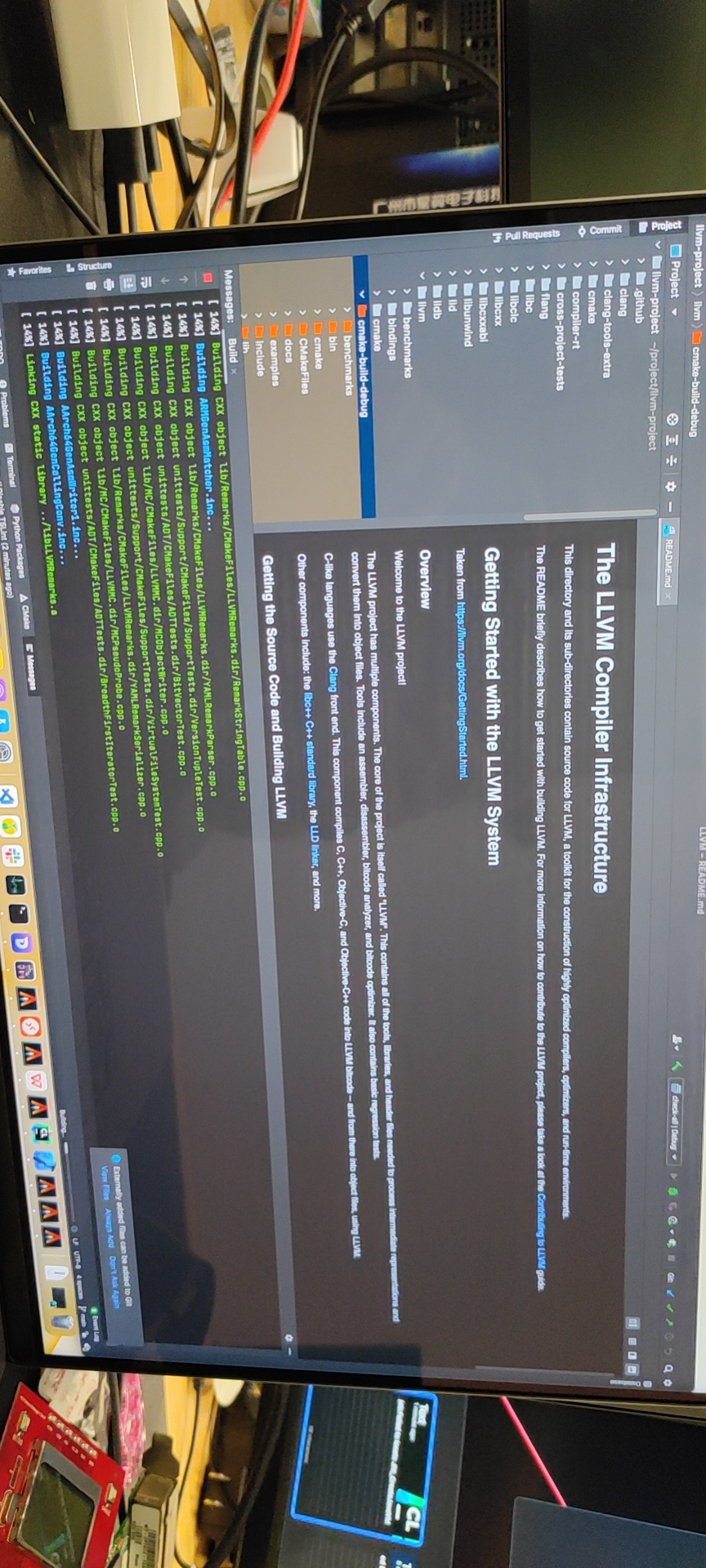
LLVM all 14分钟就编译完了。几乎是我9700k的2倍。我终于实现了rust电量自由。
花了半个月,11月23号早上就到货了,本来是一个月才到货,这也是一个小惊喜吧。买这个本的初步想法就是学习arm汇编,同时尝试反编译一下metal api到苹果的asic的过程。总之就是想花钱买开心。

LLVM all 14分钟就编译完了。几乎是我9700k的2倍。我终于实现了rust电量自由。
在北京时间11/16日早上9点半至11/18日早上7点半超算队线上参加了SC21-SCC,这是本年的最后一战,我是按照我的最后一次比赛的标准来准备的,毕竟有申请和科研,之后也不会这么好玩的参与比赛了,以后可能为了智商保持参加一下ctf。在准备和规划上和比赛进行时有挺多出入的,所以只能说我带领的同学很好的各司其职,失败的原因我更愿意归咎于我的Timing的能力。不过我也明智在多找了几个运维高手。
预算是开始时给出的,在Azure上只有1500USD,在另一个今年新加的Oracle机器上不限,下面标*的是在oracle上跑的题目。 SC21的题目很早就放在网上了,大概有

poster比清华低1.*分,benchmark低4分,QE高2分,mystery低2分,最后低了5分左右。而benchmark和mystery都是卡的竞争导致的差距,也可以说是我们学生临场发挥的能力略逊于清华。
千万不要以为proposal就是全部,毕竟当时还不知道多少预算,我们就大概糊了一个什么时候跑啥的tactic。我们预想着是第二天凌晨的时候开始benchmark,这对我的指挥失误有些影响,那时候根本抢不到A100. 同时我们在比赛开始前就注意到标*的是接近免费的机器,只是到比赛的时候才知道才0.0021USD每小时,主办方确认能用,我们一早就把所有这种以v5结尾的测试机器先拿了,quota到限制了,别人就完全拿不到了。
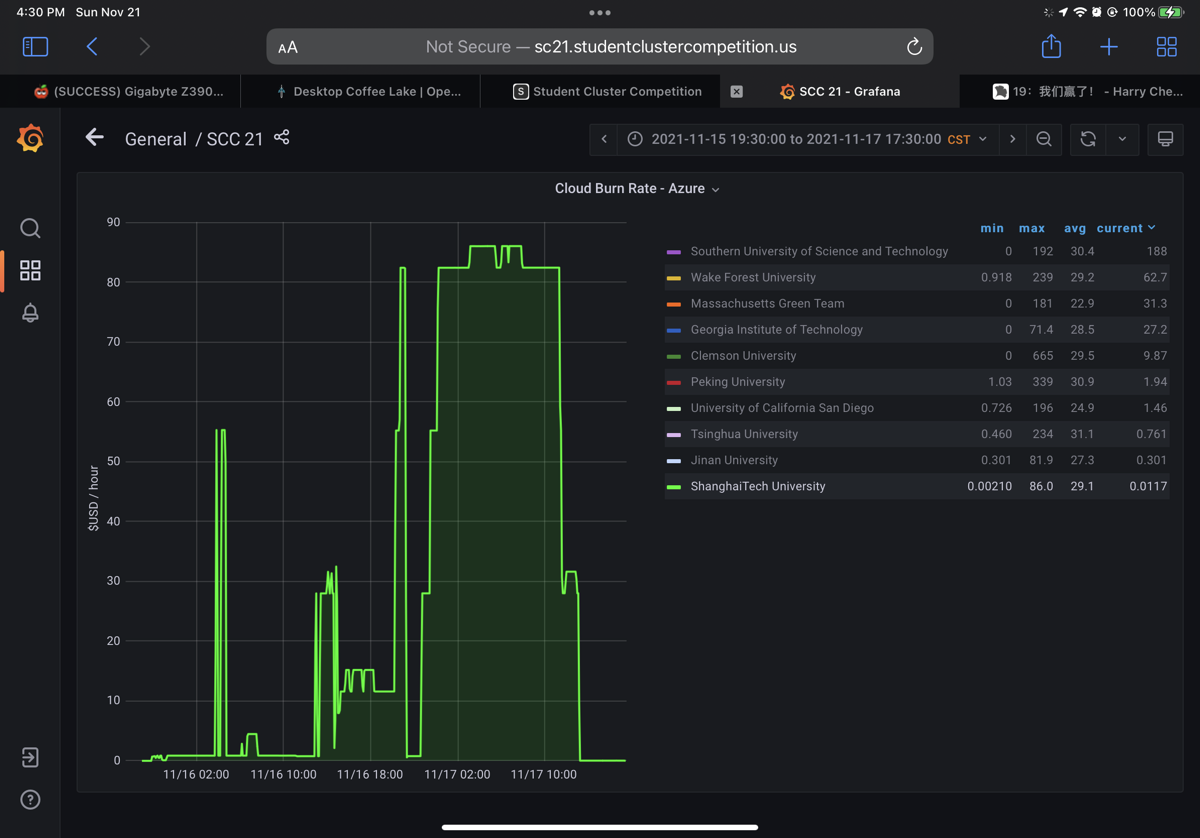
我们claim说我们能完成spack integration,比赛前也确实完成了,我们给所有azure机器加了一个启动脚本用于给我们自己的slack发脚本,这最终导致我们免费slack消息超出10K条(以后得找学校赞助了。)
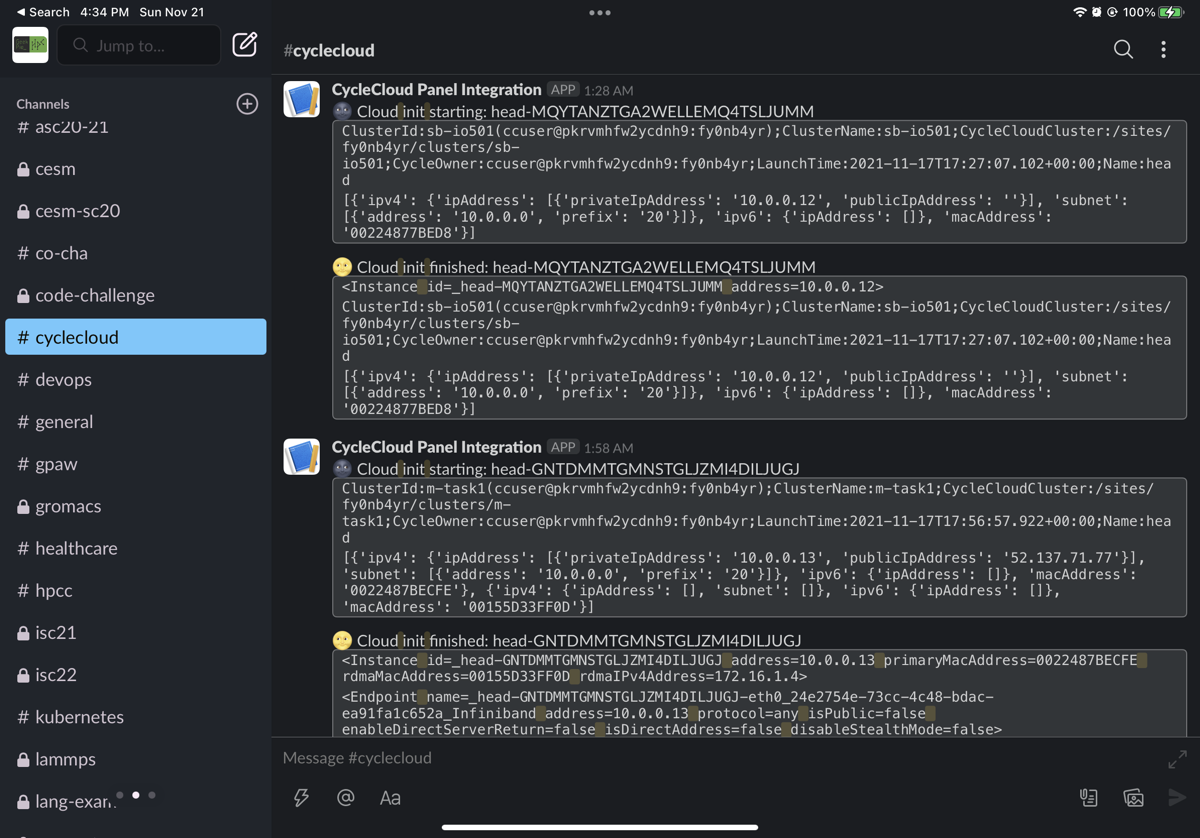
cycle cloud 之所以别人玩不来是因为有很多坑,而我们有王凯留(运维最省钱了)。他精通powershell,ruby。普通的image只能得到chef error等问题,大概只有北大和暨南使用的centos7可以过,但进去还是会有坑。在确定使用microsoft-dsvm:ubuntu-hpc:2004:latest这个能自动装好所有我们想要的东西(spack,go,rust)的基础上,他用cloud-init干了自动配置他自己编译的slurm,把他的--noswtich=0以及--shutdown=none还有cyclecloud.so编译进去。后来通过反编译他的那个.so只干了指定参数的作用。主要的流程,比如更新slurm机器状态都是jetpack做的。BeeGFS他后来编译了一个5.x内核可用的template,最后也上production了。最最重要的是,他在处理chef问题的过程中找到了cyclecloud如何确定整个区域谁拿走了什么机器的API,他之后用此写了很多脚本。还有更令人搞笑的事情,为什么azure cyclecloud 会用chef?因为巨硬收购了一家cyclecomputing的公司先一步踏入云超算市场,可是infra都还是之前那个公司的legacy开发。总之oracle现在上来了,巨硬现在要重新用ansible写一遍了吧,如果微软日本员工看到了,一定要招王凯留帮你们写infra筽,一个启动时两个apt相互抢锁PR如下,一个chef安装时只用rpm的so覆盖deb的脏做法PR如下!
总之同学们都写好脚本了,都开源了,大概就花了几天时间搞定的事情,比赛时就不用操心了,不过那几个队员做完题目也没能力再帮别人了,这也是人员上没清华有弹性的原因.不过我们这题做的好,和THU差不多吧。
这次我主要负责QE,QE总之我们是研究的非常透彻的,在自己机器上tune了多卡(发现了很多坑。这当然都是早就解决了的,测例我们一开始就选择的是AUSURF,后面也是原题,只是精度有点差别,需要更多的显存。我们尝试改了一版Vkfft,后来没cufft快就放弃了,还试图搞了异构,花了挺多时间的,不过这也给他们当并行计算final project了,至少没白花时间。Cardioid我和jyc好好优化了一下,其实就改了一个set和一个MPI_Reduce,就说最后运行的机器只有单机八卡,他之前的做法是要到500nodes才有效果。所以我们就为单node优化了。
在ISC结束的时候我拉了一位和我一起写和清华MadFS差不多思路的文件系统,但使用不同实现,不用UCX而用ibverbs,不用rocksdb写放大而用concurrent ART Tree。可是那个同学锅更多,就give up了(所以问题是我校人数太少,PUA太多)。
开始的时候我们莫名其妙开始跑了,原来是和BU他们名字搞反了,巨硬养老院的Andy是真靠不住。换回来后我们还莫名其妙多了30USD。貌似也退不了。比赛到1个小时的时候莫名我们nfs的home被删了,我们理解为是惊喜。我们重装了了一遍集群才搞定,幸好都是自动化的。Azure上面每台机器只有20G的本地磁盘,/tmp经常写爆,所以只能export TMP=/mnt/shared/tmp。只是注意什么启动阶段什么东西好了。
Q-E很快就用上了"免费机器",我们申请了650core的免费机器跑AUSURF,时间和cost都是全场第一。第二个测例和第三个测例我查了一下网站,算了一下,发现分别nk=4和ntg=2/npool=4最好,加上特调的binder.sh,以及1台8卡A100还有和Ye Luo的唠嗑,我们拿了接近满分。这是第一次拿到两台A100(ND96)的时间。
在第二次高峰的时候我们准备放benchmark,murez咕了去搞mystery app了,有很多坑,现在nfs上面配好。我就负责了HPL和HPCG。第一次拿到的时候发现就拿不到3台以上了,于是通过计算得到全场只有8台8卡A100,我们果断切了另一个集群用脚本抢。可是还是只有三台。总之,不如用于憋死别人吧。至少北大比我们晚一点就没了,导致他们和清华只能用V100.我在这里跑了1次HPCG和10次HPL后就被mystery app的自动调参机接管了,不过mystery app刚开始的时候就有问题,是mpi没配对,准确的说是mpi用了错误的libmpi.so.12,经验不足训练不足吧。这让murez很紧张,这大概浪费了1小时吧,后来我帮他编译成功了。他就任性的用满显存搞事情。全精度,半精度,混合精度的他把batch size调到正好24卡A100从而获得最好性能,不过遗憾是我们没用本地的机器,所以参数都是真的看到结果反哺去调的,清华可以在自己的机器上拿到不错的参数再继续,可是我们社连A100都没有啊,总之就只能这样了(他们用同样的A100机器也能做的比我们好一些,因为参数). IO test是放在tmpfs上跑的,跑了1400,(这里清华可以over madfs。)我们这个阶段也没钱拿HB120rs用于BeeGFS了,所以IO test是不行了。
IO500 最后也没写完,所以最后我们拿了Optane SSD的单盘测试的,拿了个27.2
发现清华的学生不是状元就是金牌,这些令人仰望的人,我们学校培养的学生,是职业的,有学术训练的工程师和研究者,只能说有阶段性胜利,让我校进出口未来会好一点吧(多来点OI银牌。
总之还有有一点进步空间,只是对我来说没有下一次了,如果这次是最后一次,也许我请的那个人会和我一起写完。不过,真的能提升的也只有日常训练,对代码对系统对AI System的理解。
root@epyc:~# uname -a
Linux epyc.node2 4.19.0-18-amd64 #1 SMP Debian 4.19.208-1 (2021-09-29) x86_64 GNU/Linux
root@epyc:~# ldd --version
ldd (Debian GLIBC 2.28-10) 2.28
Copyright (C) 2018 Free Software Foundation, Inc.
This is free software; see the source for copying conditions. There is NO
warranty; not even for MERCHANTABILITY or FITNESS FOR A PARTICULAR PURPOSE.
Written by Roland McGrath and Ulrich Drepper.
In cases of quantum espresso
mpirun -hostfile ../AUSURF112/host --mca pml ucx --mca btl sm,rc,ud,self --mca btl_tcp_if_include 192.168.10.0/24 --bind-to core -x PATH -x LD_LIBRARY_PATH -x OMP_NUM_THREADS=1 -np 256 /home/qe/sb/bin/pw.x -nk 4 -nd 64 -i ./grir443.in > 11_7_out256 2> 11_7_out256err
It would dead for a while
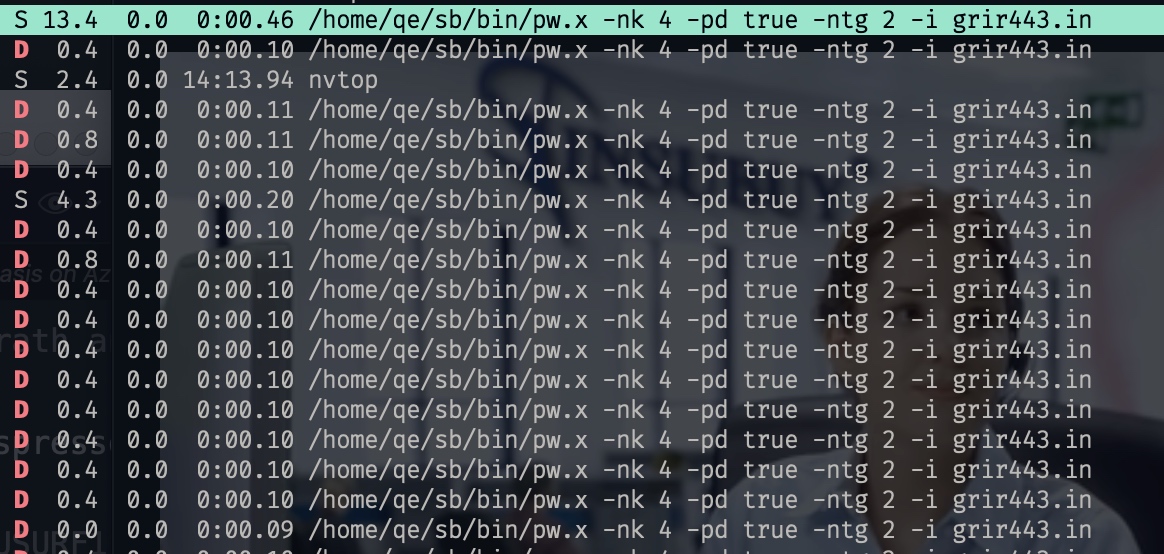
The bug is reported by pthread_rwlock.

diff --git 2.28/nptl/pthread_rwlock_common.c 2.29/nptl/pthread_rwlock_common.c
index a290d08332..81b162bbee 100644
--- 2.28/nptl/pthread_rwlock_common.c
+++ 2.29/nptl/pthread_rwlock_common.c
@@ -310,6 +310,7 @@ __pthread_rwlock_rdlock_full (pthread_rwlock_t *rwlock,
if (atomic_compare_exchange_weak_relaxed
(&rwlock->__data.__readers, &r, r | PTHREAD_RWLOCK_RWAITING))
{
+ r |= PTHREAD_RWLOCK_RWAITING;
/* Wait for as long as the flag is set. An ABA situation is
harmless because the flag is just about the state of
__readers, and all threads set the flag under the same
Yesterday I'm dealing with a Rust pitfalls like below:
pub struct IBStream<'a> {
qp: Arc<ibverbs::QueuePair<'a>>,
cq: Arc<ibverbs::CompletionQueue<'a>>,
mr: ibverbs::MemoryRegion<RdmaPrimitive>,
pd: Arc<ibverbs::ProtectionDomain<'a>>,
ctx: Arc<ibverbs::Context>,
}My initiative is to make the IBStream initial in parallel. As for implementation of ctx is an unsafe code to consume CompletionQueue and cq, mr and pd have different lifetimes, so on initiate the struct, we couldn't make sure ctx's lifetime is long lived than IBStream. We couldn't write the could as below:
pub fn new<'b, A: ToSocketAddrs>(addr: A) -> Result<IBStream<'b>, IBError> {
let ctx = Self::setup_ctx()?;
let ctxr: & _ = &ctx;
let cq = Self::setup_cq(ctxr)?;
let pd = Self::setup_pd(&ctx.clone())?;
let qp = Self::setup_qp(&cq.clone(), &pd.clone(), &ctx.clone())?;
let mr = pd.allocate::<RdmaPrimitive>(2).unwrap();
Ok(IBStream {
qp,
cq,
mr,
pd,
ctx,
})
}
The library function specify such lifetime to let the user have to take care of ctx and cq's lifetime, which has some senses. But these thinking of lifetime is too tedious for fast deployment.
How to solve the problem? As Jon put, there's library called ouroboros that the data in the struct has the same lifetime with the outer struct, that they are created and destroyed at the same time.

#[ouroboros::self_referencing]
pub struct ClientSideConnection<'connection> {
cq: CompletionQueue<'connection>,
pd: &'connection ProtectionDomain<'connection>,
#[borrows(cq, pd)]
#[covariant]
qp: QueuePair<'this>,
}When using the struct, if we have to specify the static in one function.
let client = client as *const BadfsServiceClient;
// this is safe because we move client into closure, then execute the closure before function returns
let client:&'static BadfsServiceClient = unsafe{client.as_ref().unwrap()};Another problem, if I want to specify a lifetime inside a function but the borrow checker think it's not, we could cheat it with the same trick.
All in all, borrow checker is easy to cheat.
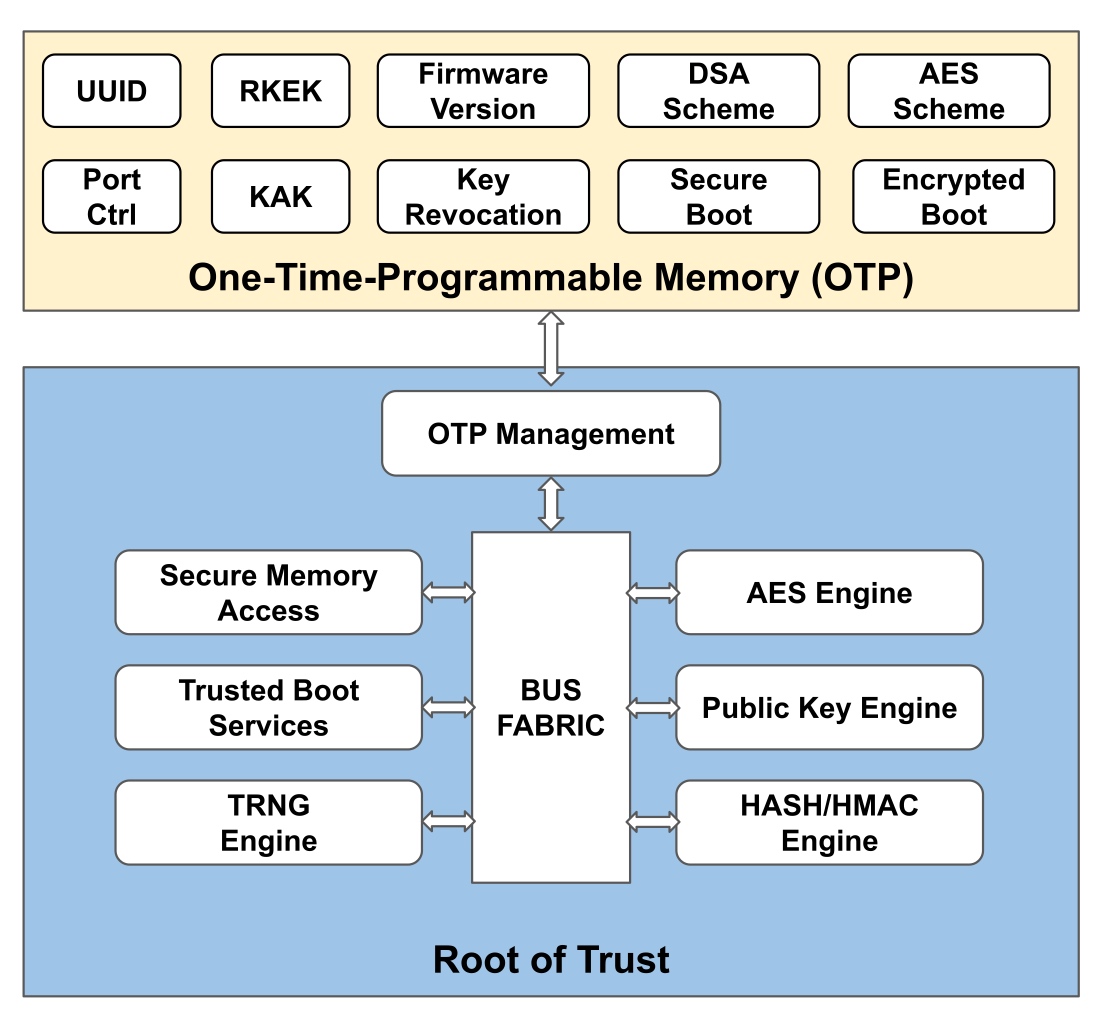
Here's the graph extrated from [1], essentially to tell the root of trust. A secure system depends on every part in the system to cooperate. For SGX, the Trusted Computing Base(Trusted Counter/ RDRAND/ hardware sha/ ECDSA) is the memory region allocated from a reserved memory on the DRAM called the Enclave Page Cache (EPC), which is initialized at the booting time. The EPC is currently limited to 128MB (in IceLake, was raised to 1TB with weakened HW support. Only 96 MB(24K*4KB pages) could be used, 32MB is for various metadata.) To prevent distruptions by physical attack or previledge software attack from cacheline-granularity modification, every cacheline can be assoiciated with a Message Authentication Code(MAC), but this does not prevent replay attack. To extend the trusted region of memory and do not introduce huge overheads, one solution is put the construct the merkle tree, that every cacheline of leaf is assured by MAC and root MAC is stored at EPC. Transaction Memory Abort with SGX can be leveraged to do page fault side-channel. The transaction memory page fault attack on peresistent memory is still under research.
For Riscv, we have currently 2 proposals - Keystone and Penglai for enclave and every vendor has different implementations. Keystone essentially utilize M- mode PMP limited special registers the control permissions of U- mode and S- mode accesses to a specified memory region. The number/priority of PMP could be pre-configured. and the addressing is mode of naturally aligned power-of-2 regions (NAPOT) and base and bound strategy. The machine mode is unavoidable introduce physical memory fragmentation and waste: everytime you enter another enclave, you have to call M- mode once. Good Side is S/U- Mode are both enclaved by M- mode with easy shared buffer and enclave operation throughout all modes. Penglai has upgraded a lot since its debut(from 19 first commit on Xinlai's SoC to OSDI 21). The originality for sPMP is to reduces the TCB in the machine mode and could provides guarded page table(locked cacheline), Mountable Merkle Tree and Shadow Fork to speed up. However, it introduce the double PMPs for OS to handle, and overhead of page table walk could still be high, which makes it hard to be universal.
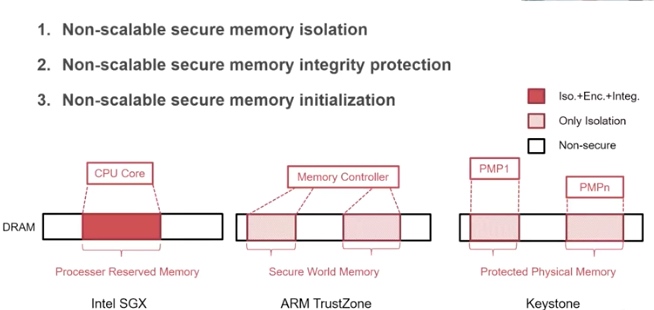
Starting from Penglai, IPADS continuously focus on S- mode Enclaves. One of the application may be the double hypervisor in the secure/non-secure S- Mode. The Armv8.4 introduce the both secure and non-secure mode hypervisor originally to support cloud native secure hypervisor. TwinVisor is to run unmodified VM images both as normal and confidential VMs. Armv9 introduce the Confidential Compute Architecture(CCA), another similar technology. TwinVisor is an pre-opensource implementation of it.
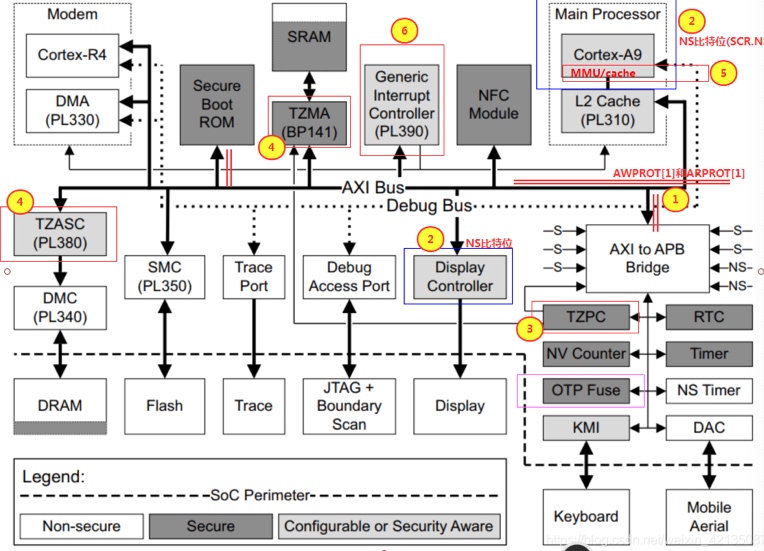
supported trustzone extention starting from Armv7.

The author mentioned physical attack or previledge software attack from N-VM to S-VM, this can be prevent by controlling the transmission channel.
TACTOC attack led by Shared Pages for General-purpose Registers, check-after-load way [50] by reading register values before checking them.
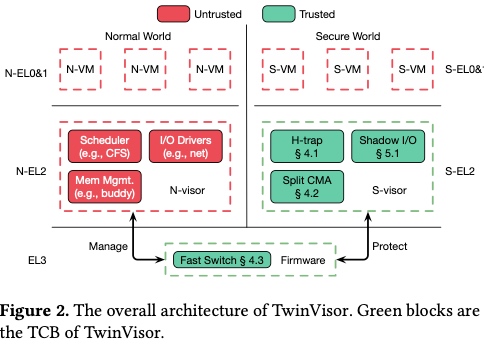
Horisontal trap: modifies the N-visor to logically deprivledge N-visor without sharing the data. Exeptional Return(ERET) is the only sensitive instruction affect trusted chain, it intercepted by TZASC and repoted to S-visor.
Shadow S2PT: shadow page table of VSTTBR_EL2, used in kvm, too. It has page fault with different status when in different world.

Split Continuous Memory Allocation: Tricks to improves utilization and speed up memory management in Twinvisor. In linux, buddy allocator used to decide a continuous memory is big enough for boot and do CMA, this is for better performance of IOMMU that require physical memory to be continuous. (This deterministic algorithm makes it easy for memory probing and memory dump by e.g. row hammer/DRAMA ).
Efficient world switch: change NS bit in SCR_EL3 register in EL3, side core polling and shared memory to avoid context switches
Shadow PV I/O: use shadow I/O rings and shdow DMA buffer to be transparent to S-VMs. reduce ring overhead by do IRQ only when WFx instructions.
The world switch does not happen so frequently.
Kirin 990. (Not scalable to Big machines, because KunPeng920 is not yet Armv8.4, scability is not convincible)


Currently, I'm busy writing emails for my Ph.D and taking TOEFL and taking care of the Quantum ESPRESSO library changing and MadFS Optimization, so it may waste some time. Till now, I have to apply the DTA tool of phosphor for the java order dependency project.
mvn install -Dmaven.surefire.debug -f /Volumes/DataCorrupted/project/UIUC/bramble/integration-tests/pom.xml and attach the trace point.
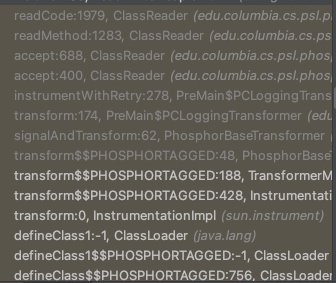
This outputs only the dependency for one test introduced in Oracle Polish JPF. For dependenct between test1 and test2,
For NPE, get the pair by idflakies test first.
Reference
cmake 通过修改开关,只让GPU使用 ptx 及 fortran intrinsic ABI 直接编译,替代 OpenACC的 kernel 实现。MPI 库实现替换为 ucx gpr_copy. AUARF32 时间从 4m59s 提升至 1m51s。 但在多卡上仍就有很大的通讯开销。由于 cuda_ipc 在 x86 架构上只能通过 PCIe 传输,4卡高达1小时左右。即便是开了-nk 2的情况下。 issue
针对 AUARF112 测试案例,在针对 core.F90 中的 scf 场进行 cache 调优
最近参加了软工顶会和操作系统相关顶会,由于之前没有学生申请,这次被完美坑了200🔪。不过总的来说收获颇多,大概知道了一个博士毕业生需要的水平和付出。
I inspect the the major quality first I met those who have great progress in their Ph.D. period and in their tenure track is the persistent energy. They seems to have endless insights and devotion to one specific idea and broad idea through the thorough world. That accounts for the philosophy of the point and the plane. Like the round pegs in the square holes, we never shows satisfaction with the current worlds' poor knowledge over no matter an engineering problem or a mathematical problem.
Continue reading "My introspect from food for thought by mentors"
NVOverlay is a fast technique to make fast snapshot from the DRAM or Cache to make them persistent. Meantime, it utilized tracking technique, which is common to the commercially available VMWare or Virtual Box on storage. Plus, it used NVM mapping to reduce the write amplification compared with the sota logged based snapshot.(by undo(write to NVM before they are updated) or redo may add the write amplification. To specify not the XPBuffer write amplification, but the log may adds more writing data)
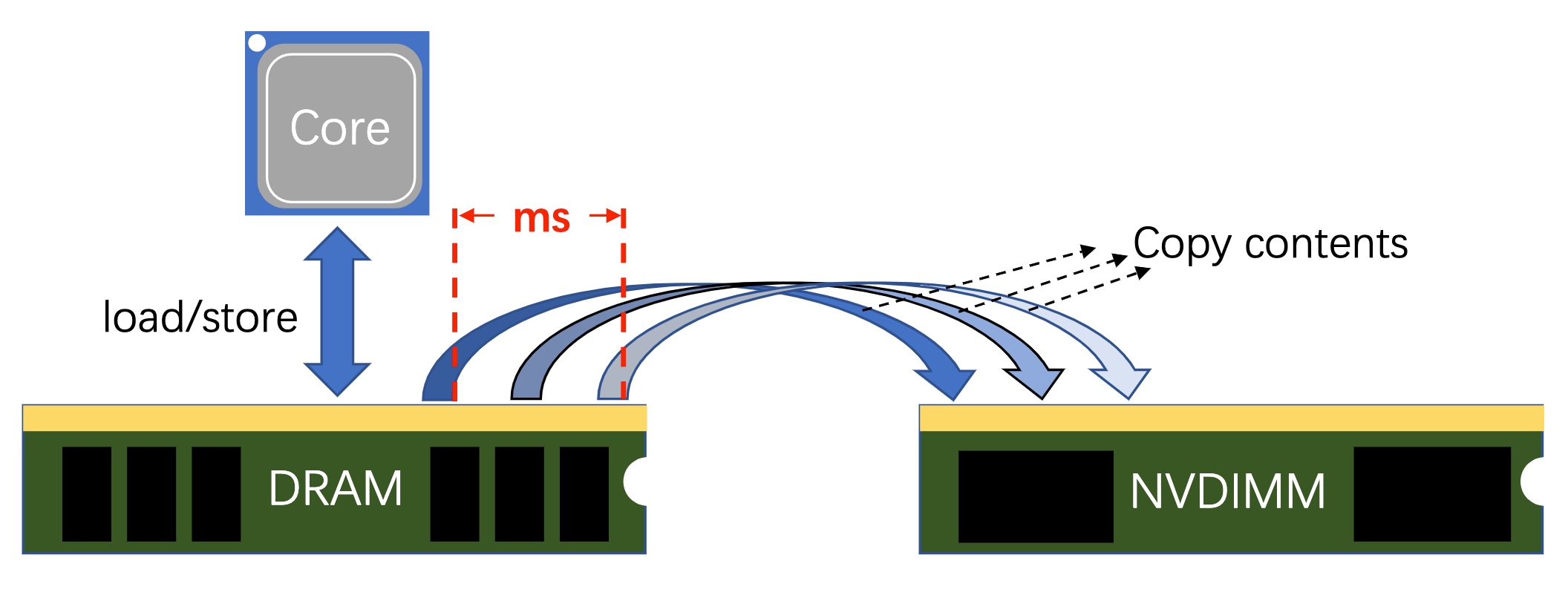
So-called High-frequency snapshotting is to copy all the possible data in a millisecs interval when CPU load/store to DRAM. Microservice thread may require multiple random access to MVCC of data, especially for time series ones. To better debug the thread of these load/store, the copy contents process should be fast and scalable.
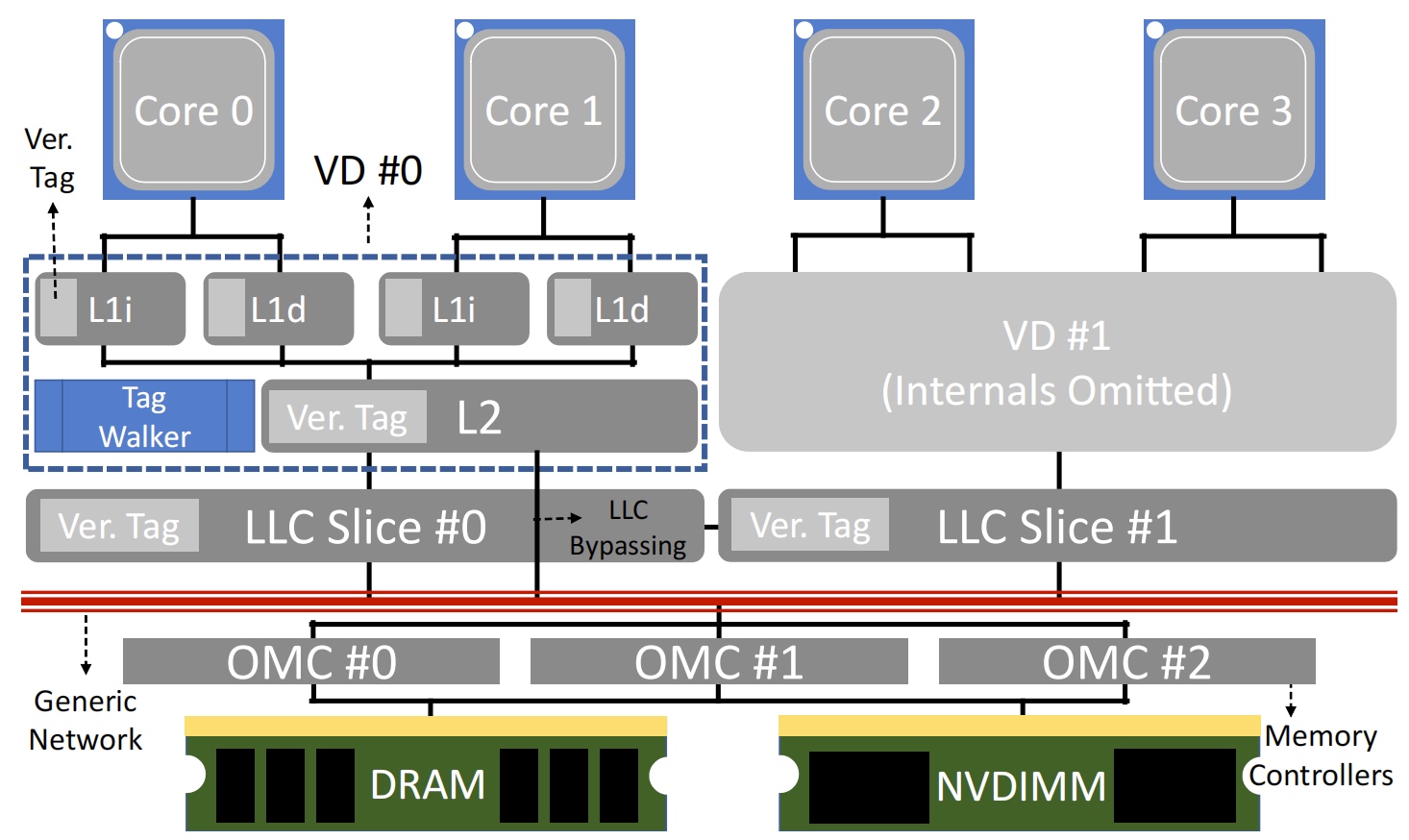
here OMC means overlay memory controller
The cache coherency is considered deeply. For scalability to 4U or 8U chassis, they add a tag walk to store the local LLC tag. We know that all the LLC slice is VIPT because they are shared. For the same reason, the tag can be shared but unique to one shared space.
For a distributed system-wide problem that have to sync epoch counters bettween VDs, they used a Lamport clock to maintain the dirty cache's integrity.
Continue reading "NVOverlay: Enabling Efficient and Scalable High-Frequency Snapshotting to NVM"